#but atum’s history only helps really
Explore tagged Tumblr posts
Text
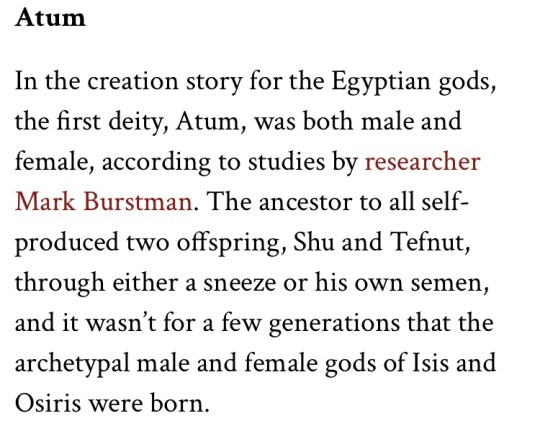

like I said, Terence T D’Arby is trans
38 notes
·
View notes
Text
Random thoughts about Moon Knight s01e03...
(spoilers ahead)
Ok, so I have a theory about Harrow but that's a separate post.
Marc fighting done guys, blacking out because Steven took over, coming back and immediately chasing the same guys all over again before blacking out again? I know it wasn't meant to be funny, but damn, that was funny.
NEW ALTER! Marc didn't kill those guys and, obviously, neither did Steven, but they both lost time. How much do you want to bet it's Jake?
On that note- Steven, baby, I know you're a pacifist but PLEASE stop trying to interfere with the fights.
Khonshu talking through Marc, is such a dramatic fuck.
So Khonshu summoned the gods and Hathor, Isis, Osiris, Tefnut, Horus showed up. That means that depending on who they include in this universe, Geb, Shu, Nut, Set, Nephthys and Atum are missing... I'm curious why. Also, I saw that Bast statue, waiting for a Wakanda easter egg.
MADRIPOOR??
Steven is such a NERD! I love him.
Hate that they didn't even hear what Harrow did, didn't even check. The moment he shifted the discussion to Marc being ill, they all forgot the matter at hand. That whole thing was pointless.
Marc admitting he is unwell and needs help but still trying to prioritize the world and stopping Harrow... My darling. 😭
Marc really needs to learn to communicate with Layla instead of just apologizing and keeping secrets.
Of course, Mogart, the philanthropic protector of ancient artifacts, is some white dude hogging culture that isn't his.
Marc and Steven learning to work together. 🥺
Please tell me Marc didn't kill Layla's father! Let's not do that. In the comics the guy died but Marc tried to save him and only managed to save the daughter, perhaps the big secret is that Marc feels bad for failing.
Layla's necklace! 😱
Steven interrupting the fight, getting impaled, and immediately regretting everything was the most hilarious thing ever. It made my day.
Khonshu needs to start respecting my man Steven. Aka "worm (affectionate)"
Marc being the bigger man and giving Steven the body because he's the best equipped for the situation. Working together ftw!
"and voila! ... That's french." Steven, my little mythology, history and puzzle nerd. ❤️
Wait, does Khonshu being imprisoned mean that Marc/Steven have no powers whatsoever now? Holy shit.
Another gorgeous ending song! I'm loving this trend of every ep having a different ending song.
EDIT: Did you guys notice how every shot of Marc's chest always cut off just shy of the Star of David so we never see it? What's up with that?
All in all, another episode. I am LOVING this show! It kills me that it will be so short, I hope we at least get another season...
11 notes
·
View notes
Text
What does it mean to be pagan? (Paganism 101 Ch. 1)
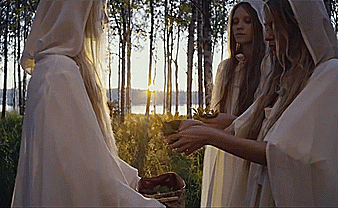
That’s right, y’all! With Baby Witch Bootcamp officially wrapped, it’s time to jump into our next long term series! I put out a poll on Patreon, and my patrons voted for Paganism 101 as our next series. While not all witches are pagan and not all pagans are witches, there is a lot of overlap between the two groups. Both witchcraft and paganism offer practitioners a sense of freedom, a deeper connection to the world around them, and a greater awareness of their personal power.
I identify both as a witch and as a pagan, and I get a lot of questions about paganism. In this series, we’ll go through the basics: what it means to be pagan, the difference between a neopagan and a reconstructionist, and the role of magic in different pagan traditions. We’ll also talk about some of the most popular modern pagan traditions and how to find the right tradition for you.
Let’s start off by answering the question, “What does pagan actually mean?”
Defining “Pagan”
It’s important to remember that “pagan” is an umbrella term that encompasses a wide range of different faiths. Someone who practices Wicca, for example, will have very different beliefs from someone who practices Hellenismos. These different faiths are linked by a shared history, rather than by shared beliefs or practices.
The word “pagan” comes from the Latin “paganus,” which literally means “area outside of a city” or, to phrase it slightly differently, “countryside.” This adjective was used to describe people and things that were rustic or rural and, over time, came to also have the connotation of being uneducated. Originally, the word had no religious association, and was even used to refer to non-combatants by the Roman military.
From this definition, we can gain some insight into what makes a religion or practice pagan. Pagans feel a kinship with the wild or rural places of the world, and are comfortable waking “off the beaten path.”
But how did “paganus” come to refer to a type of religion, anyway?
To understand the religious meaning of “paganus,” it’s necessary to understand a little bit about the religion of Ancient Rome. Rome (the city) was built inside a pomerium, a sacred boundary that formed a spiritual border around the city and its people. Paganus folks were those who lived outside the pomerium and, as such, may not have been strict adherents of the state religion — they certainly wouldn’t have been able to travel into the city for every major festival. They may have gotten a bit more creative with their worship of the gods. However, as previously stated, the word paganus did not have an explicitly religious meaning in ancient times.
The use of paganus as a religious label began after the legalization of Christianity by the Roman Emperor Constantine in 313 C.E. Christianity would not be adopted as the official state religion until 380 C.E., but Constantine’s conversion and decriminalization of Christian worship paved the way for Rome’s transformation into a Christian state. It was around this time, as Christianity was quickly growing in urban areas, that early Roman Christians began using the word “paganus” to refer to those who still practiced polytheism. Rather than referring to those outside the city’s boundary or to untrained civilians, the label now referred to those outside the Church, those who were not “soldiers of Christ.”
As Christianity spread in popularity throughout the Mediterranean, Europe, and Northern Africa, the pagan label was applied to all non-Christians in those areas. The word “pagan” became a derogatory label, implying an inferior and backwards religion.
So, really, the thing that makes a religion pagan is a historical conflict with Christianity. Pagan religions are those that were suppressed or completely destroyed after Christianity became the dominant faith in the region.
This is why Norse Paganism and Kemetic (Egyptian) polytheism, which are very different, are both considered “pagan” while Shinto, a Japanese religion that shares a lot of common features with many pagan faiths, is not. Because Christianity never achieved total dominance in Japan, Shinto was never pushed aside to make room for Jesus.
In the 20th century, people who felt drawn to these old religions started to reclaim the pagan label. Like many other reclaimed slurs, “pagan” became a positive label for a community united by their shared history.

What do all pagans have in common?
This is a tough question to answer because, as stated above, paganism is a historical definition, not one shaped by belief or practice. However, there are some things most pagans have in common. Here are a few of them, although these concepts may take different forms in different traditions.
Paganism…
… is (usually) polytheistic. Most pagans do not subscribe to monotheism, the belief in a single, all-powerful divine being. Some pagans are polytheists, meaning they believe in multiple divine beings with varying levels of power. Hellenic pagans, Norse pagans, and Celtic pagans are typically polytheists. Still others are monists, meaning they believe in a single divine source that manifests itself as multiple gods. Wiccans and other neopagans are typically monists. Many pagans fall somewhere in-between strict polytheism and strict monism. We’ll talk more about polytheism in a future post, but for now just know that the idea of a single, supreme creator is not compatible with most forms of paganism.
… is based in reciprocity. This is a concept that may seem odd to those who grew up around Abrahamic religions: the idea of engaging the gods in a mutually beneficial partnership, rather than one-sided worship. When we connect with the gods, we receive spiritual, emotional, and physical blessings. The gods also benefit, as they are strengthened by our prayers and offerings. (I like to think they also enjoy the company. It has to be lonely, having your body of worshipers supplanted by an anarchist carpenter from Palestine.) The concept of reciprocity is why most pagans make physical offerings to their gods.
Reciprocity also extends to our relationships with other people. Most pagan religions have a code of ethics that includes values like hospitality, kindness, and/or fairness with others. Depending on the pagan, reciprocity may even extend to the dead! Many (but not all) pagans practice ancestor worship, the act of honoring and venerating the beloved dead.
Reciprocity may even extend to the world at large. Some (but not all) pagans are animists, which means they believe that every animal, plant, and stone contains its own spirit. Animist pagans strive to live in harmony with the spirits of the world around them, and may make offerings to these spirits as a sign of friendship.
… embraces the Divine Feminine. Paganism acknowledges and venerates both masculine and feminine expressions of divinity. Polytheist pagans worship both gods and goddesses, while monist pagans see the divine Source as encompassing all genders. In either case, the end result is the same: pagans acknowledge that, sometimes, God is a woman. (Cue the Ariana Grande song.)
Paganism also acknowledges gender expressions outside the masculine/feminine binary. Many pagan deities, like Loki (in Norse paganism), Atum (in Kemetic paganism), and Aphroditus (a masculine aspect of the Greek Aphordite) exist somewhere in the grey area between man and woman.
… is compatible with a mystic mindset. Remember how I said there’s a lot of overlap between witchcraft and paganism? Part of the reason for that is because paganism is highly compatible with magic and other mystical practices. Most pagans believe that humans have, or can attain, some level of divine power. It makes sense that this power would manifest as magic, or as other spiritual abilities. Many of the ancient cultures modern paganism draws inspiration from practiced magic in some form, so it follows that modern pagans would as well.
… draws inspiration from the ancient stories. As we discussed, “pagan” originally referred to the religious groups that were pushed out by Christian hegemony. As a result, every modern pagan is a little bit of a historian. Because paganism was pushed underground, it takes a little digging to find myths, rituals, and prayers that can be used or adapted for modern practice.
Many pagans worship historic deities that you’ve probably read about at some point. Visit any pagan pride event, and you’ll probably find worshipers of Zeus, Venus, Thor, and Isis, just to name a few. Studying and interpreting ancient mythology and archaeological evidence is a big part of modern paganism.
… is a religion with homework. If you’ve read this far, you may be beginning to realize that being pagan is a lot of work. It’s fun, spiritually fulfilling, and very rewarding work, but work all the same. Because very few modern pagans have access to temples, priests and priestesses, or an in-person community that shares their beliefs, they end up having to teach themselves, do their own research, and guide their own practice.
This is incredibly empowering, as it means you are your own religious authority. It does, however, mean that you will occasionally have to open a book or slog through a dense academic article about the most recent archaeological find related to your favorite deity. Thankfully, there’s a growing number of accessible, beginner-friendly books, blogs, podcasts, and YouTube channels to help you in your research.
… embodies a deep respect for the natural world. While not all pagans are animists, most pagans do feel some sort of reverence for the forces of nature. Many pagan deities are associated with natural forces or use the natural world to communicate with their followers. Because of this, not only do pagans respect and love nature, but they’re constantly watching it for signs and messages. (Are you really friends with a pagan if they haven’t called you crying because they found a crow feather on the ground or saw a woodpecker in their backyard?)
Some pagan groups, especially neopagan religions like Wicca, have been classified as Earth-centered religions. Personally, I dislike this term. While it is true that many pagans feel a deep spiritual connection to the Earth and may even venerate local nature spirits, to say that these religions are “Earth-centered” feels like an oversimplification. Wiccans, for example, don’t actually worship nature — they worship the God and Goddess, who they see reflected in the natural world.
… is driven by individual spiritual practice. As mentioned above, very few pagans have access to an in-person community. Because of this, modern paganism largely consists of individual practices. Even pagans who do belong to a community still typically worship on their own sometimes. These personal practices may involve prayer, offerings to the gods, meditation, divination, astral travel, performing religious rituals, or countless other practices. Many pagans have personal altars in their homes, where they worship alone or with their family.
… is a celebration of daily life. One thing I love about paganism is how it makes every aspect of my life feel sacred. Many religions emphasize the spiritual aspects of life while deemphasizing, or even demonizing, the physical or mundane aspects. This can lead to practitioners feeling like they are spiritual beings trapped in a physical body, or like their physical needs and desires are something to escape.
Paganism allows practitioners to fully enjoy being physical and spiritual beings. Pagans reach for the heights of spiritual awareness, while also enjoying earthly delights — recognizing that neither is inherently more worthy than the other and that both are needed for a balanced life.
… is only one of many paths to Truth. Most pagan groups do not claim to be the only valid religious path, and in fact several openly acknowledge the validity of other religions. This is why you rarely see pagans trying to convert other people to paganism — it’s openly acknowledged that paganism isn’t for everyone, and that those who are truly meant to practice the old ways will find them.
~~~
Hopefully, this post has given us a good working definition of “paganism.” From here, we’ll explore some of these individual concepts in more depth and discuss specific religions within the pagan umbrella. Until then, blessed be.
Resources:
Wicca for Beginners by Thea Sabin
Wicca: A Guide for the Solitary Practitioner by Scott Cunningham
A Witches’ Bible by Janet and Stewart Farrar
The Way of Fire and Ice by Ryan Smith
Where the Hawthorn Grows by Morgan Daimler
Temple of the Cosmos by Jeremy Naydler
A Practical Guide to Irish Spirituality by Lora O’Brien
#paganism 101#pagan#paganism#pagan witch#neopagan#wicca#wiccan#feri#reclaiming#goddess worship#celtic paganism#irish paganism#hellenismos#hellenic polytheism#religio romana#heathenry#germanic paganism#norse paganism#kemetic polytheism#kemetic paganism#animism#ancestor worship#eclectic pagan#polytheism#divine feminine#goddess#mythology#theology#history#witch
267 notes
·
View notes
Text
Ma’at

There are, needless to say, a lot of Egyptian Gods. Because of this I’ll be doing these little pages for my favorites and, if I feel like it later on, I will progress to the other Gods and Goddesses. I probably won’t do Ra mostly because he’s well known and I dislike him immensely (do not ask me why). Anyway, here’s one of my top Egyptian Gods: Ma’at.
Ma’at is interesting because she’s more of an idea than an actual deity. Her name is mentioned a lot, but she herself is not mentioned very often, as her law was more important than her being. Fair enough – her law was peace, order, and in Nuclear Family Ancient Egypt, order was held above all else. Everyone partook in holding up the sacred law of ma’at. In this way she was a bit like Heka, who was the personification of magic, not just a God of magic.
I had a little difficulty with this, so I’ll start out by saying her name is generally pronounced as May-et. She first appeared in the Old Kingdom, though it’s generally agreed upon that she existed in some form before that. As one of the oldest Gods, she was created by Atum with help from Heka, who was the personification of magic. Supposedly she was around at the beginning of time, being spoken into existence by Atum right after he emerged from the primordial waters. Her name, meaning ‘that which is straight,’ implies justice, order, and harmony, each of which were highly revered by ancient Egyptians.
She played an important part in death just as much as life. As you can see from her iconography, she has a feather on her head, titled the feather of Ma’at. This feather was the one used in the weighing of the hearts ceremony, which decided if the deceased would pass on to the field of reeds, or be cast into nonexistence.
To me, she’s a bit like the laws of physics but for ancient Egyptians. She was what kept the world together, she made everything rational, and she gave everything purpose. Without her, there was no society. Essentially, she made life function, and with the help of Heka (magic), she ‘powered’ the world. Egyptians revered her for this, and one of the important aspects of ancient Egyptian life was to ensure you were following ma’at by being fair to all you meet and performing your duties.
“Ma'at was the model for human behavior, in conformity with the will of the gods, the universal order evident in the heavens, cosmic balance upon the earth, the mirror of celestial beauty. Awareness of the cosmic order was evident early in Egypt; priest-astronomers charted the heavens and noted that the earth responded to the orbits of the stars and planets. The priests taught that mankind was commanded to reflect divine harmony by assuming a spirit of quietude, reasonable behavior, cooperation, and a recognition of the eternal qualities of existence, as demonstrated by the earth and the sky. All Egyptians anticipated becoming part of the cosmos when they died, thus the responsibility for acting in accordance with its laws was reasonable. Strict adherence to ma'at allowed the Egyptians to feel secure with the world and with the divine plan for all creation.” (Margaret Bunson, 152)

Unlike many Gods, she was signified in art with a plinth. Plinths were commonly seen beneath the thrones of Gods, but not with their personal name, which is where Ma’at comes in. Her name is shown with the plinth, and many researchers believe it signifies that ancient Egyptians thought Ma’at was the foundation of society. Along with that, she also helped Ra fight the serpent Apophis every night.
Another part of Ma’at that I personally really like is the fact that in many stories written by ancient Egyptians, she was a ruler of a perfect world. They speak of a world before time, a world long lost, where there was no hatred and no crime, and most times this world was ruled by Ma’at. In that way, the perfect world is one ruled by a Goddess of order and justice.
I’ve mentioned this many times, but Egyptians lived by rather simple rules that you don’t see often in modern society. It was their very, very strong belief that every person needed to take care of themselves, as well as keep in mind the needs of other people and that of the earth. In fewer words, you need to care about yourself, other people, and the earth. I think this was one of the reasons they didn’t totally run their environment into the ground like Meroe and Rapa Nui.
If you followed the above rules, your heart would weigh lighter than Ma’at’s white feather of truth. The more in tune you were with the law of ma’at, the lighter your heart was, and the better of a person you were.

Despite her popularity, Ma’at didn’t have any temples. Like Heka, her worship was limited to sanctuaries and shrines inside other temples, where people could leave what they usually left to Gods. Food, wine, and incense. Because of this she didn’t have priests either – there were those labelled a priest of Ma’at, but most historians believe the title to be more honorary than anything. So far there’s only been one temple found that was definitively dedicated to her (built by Hatshepsut), and even that one was in the district of Montu. Veneration was instead absorbed through (as previously stated) offerings and simply living by her law day-to-day. She was an aspect of every deity, and by worshipping any one of them, you worshipped her.
She was an incredibly important deity of Egypt, as you should see from her interactions in both ancient Egyptian life and society. All other Gods and Goddesses lived through her as she kept the order, thus making every temple for any God subsequently hers as well. She was “the underlying cosmic principle which made the lives of humans and gods possible.” (Joshua Mark)
A few fun facts about her: she was the daughter of Ra, or Atum. Her husband was Thoth, God of Wisdom. She bore eight children through Thoth, which came to be the primeval deities of Hermopolis. Isis and Hathor developed a few of their traits from her, though Ma’at’s importance is obvious throughout the whole of Egyptian history, just as any idea of law was in other societies.
153 notes
·
View notes
Text
Yugioh S3 Ep 29-30: LAVA GOLEM

Ah, Kaiba island.
I’m not quite sure how big Kaiba island is. In this picture it looks like we got ourselves a 6 story building on the side, but if we compare the 6 story building to the tower it’s like...that’s a 100 story building, roughly? Our art team has given up trying to make this building look like anything other than what it looks like, and they’re just going to make a metallic cross-section of a dick every time it shows up.
Also, I kinda wish we saw a little bit more of the landing sequence to get here because....

....did we do an Akira motorcycle slide into this island or is that just me?
Meanwhile, as Joey is duking it out on the world’s largest, coldest dildo, Serenity is stationed at the post she made for herself.


LOL Why did they do this? Why would they design this?
(read more under the cut)
Inside the swamp cloud, Marik is shocked that Joey has been largely unphased by this horrific experience.

Clearly Marik has not caught on that Joey’s been conditioned to this stuff living with Yugi for the past many years, and a little bit of pink spirit-sucking wires aren’t really much of a match for that time Joey saw Yugi light a guy on fire with a match once. Well, a lighter. Either way, this isn’t so bad.

And then, I don’t really talk about card games here, but Marik introduces a new card I have not seen before.
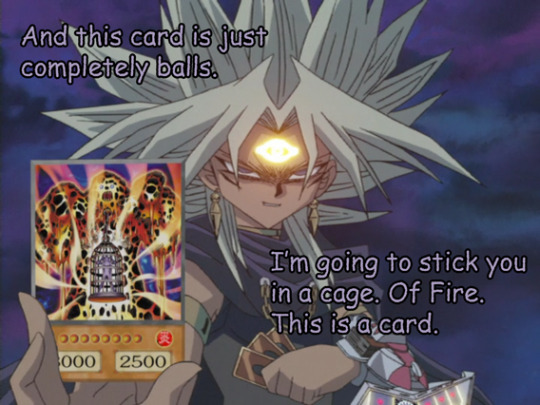

Behold, Lava Golem.

Look at him! Like I know everyone’s kinda freaking out about the new pokemon but like...Lava Golem? Remember that sweet face?
He’s just soooooo good.
Man this is the first Yugioh card ever that I’ve actually liked.


And, upon seeing this terrifying situation, Tea turns to Yugi and says:
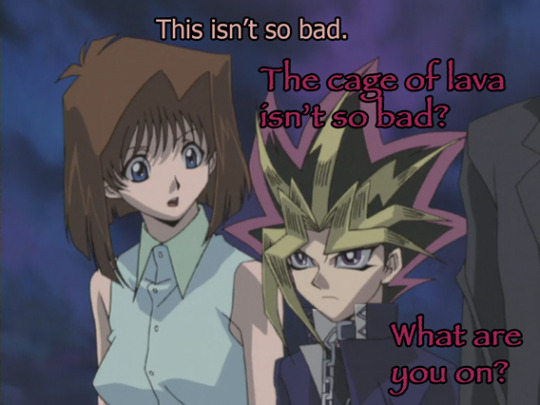
Thanks Tea.
Also during these few episodes, Marik is starting to undergo a transformation, mostly via his viens. It’s a look. Kind of worried about his blood pressure.

And I was thinking that they just invented a a chin vein, but, as it turns out, they actually did their research.

There is a vein there! I mean this isn’t really that big a deal to most of you, probably, but anime often gets a bad rap for ignoring anatomy (which ... it’s a cartoon so yeah that’s...that’s what you do in cartoons, you ignore most anatomy) but hey--they got this vein correct. I don’t know why they even bothered, but that was very nice of them to make something so gross so correct.
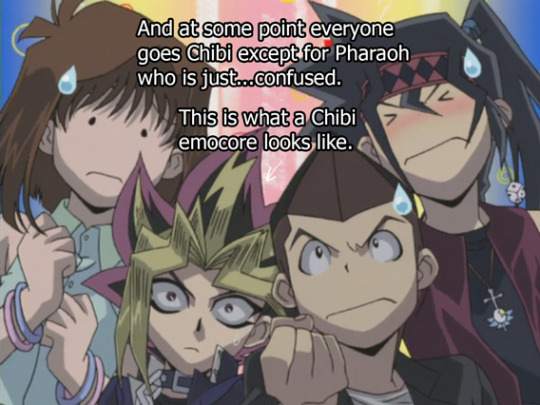
And because some of you might want this just for yourself, cap free:

Enjoy.
Along with this good boy.

Is it just me? Is it just me that’s all ham about this Domo Kun face? This Mario mini-boss?
I usually don’t like the Yugioh monster designs but this one is just...he’s such a good boy.
Anyway, the art team was told at some point to change piss cloud and they decided to do this instead

Why does the width keep changing on the tower? Like I know it was tossed between different artists but like...it just...it keeps changing and it bothers me.
Anyway, back to what matters.


Can this be our new Joey Wheeler? Just leave everything about Joey Wheeler the same but replace his sprite with Lava Golem and with no explanation. I’d be down.
I do think that this arc brought back their A-team for the animation, there was just a lot more going on visually than we’ve had in a good while. Like this Marik face, for instance--this very famous face that I’ve seen drawn on like...a whole lot of characters. This is a much-referenced pose.
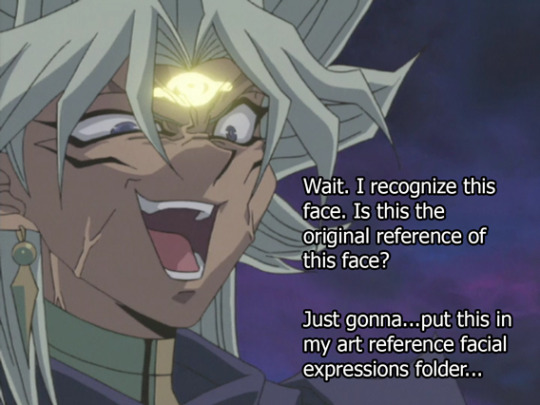
I mean, hey, not using reference while drawing is the same as dueling as Yugi Muto and just never using the Pharaoh. Like sure you could, but never, ever, ever do that.
And I just want you to know, I held that really corny anime art joke in for like a straight week on twitter as the entire world was going off about whether or not you’re supposed to use reference materials when you draw as if this is some sort of controversial topic (it’s not. No one cares about your process.) and y’all, it was HARD. But I did it. I resisted the discourse and still found a way to sneak it into here, into the side blog where I can go off about the inane art twitter discourse without getting blocked.
Which, again, was about “Can I use reference?” I...art twitter. Art twitter, I swear. why would you NOT? You have the Pharaoh, art twitter. You have the Pharaoh.
Anyway, I hope at least one of you got that joke. I hope one of you at least was like “lol--Art Reference is the Heart of the Cards.” and the next time someone tells you that using reference is cheating (which will never happen, a infinitesimal number of people in one forum on DeviantArt in 2003 said this once in the entire history of art, and I don’t know why twitter is fighting with these child-run forums that don’t even exist anymore) you can say “Don’t you dare talk about my platonic soulmate that way.” and just end the argument there.
The hell are these people who say artists don’t use reference? Do you write history papers without reading books?
And that’s my rant that was a.) too long for twitter and also b.) maybe too much anime. With art twitter it’s like..there’s no middle ground between too much anime and not enough anime. No middle ground and I have no idea where the people who follow me even stand. I think they just want to see Zelda. I think that’s about it. I really can’t tell with them. I’m like...always confused as to what those people want.
I need to delete my twitter. Anyways, back to Joey, who felt like breaking the fourth wall.


And so Marik decides to sober up and play the God card.
Yo guys, remember God Cards? I’ll be honest, I kinda completely forgot about them.

And then at some point this shot happened and I was living for it.
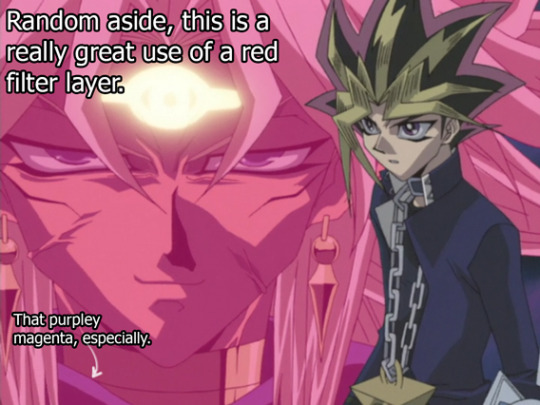
such a good idea to offset people in a different filter and kinda stack em. Bro was saying he remembered this sort of thing in Cowboy Bebop but I don’t remember what the hell he’s talking about. Bro and his spicy headcanons are mixing up Yugioh and Cowboy Bebop now. Never thought I’d see that.
And then Kaiba’s muscles kinda twitched and it looked like smiling.

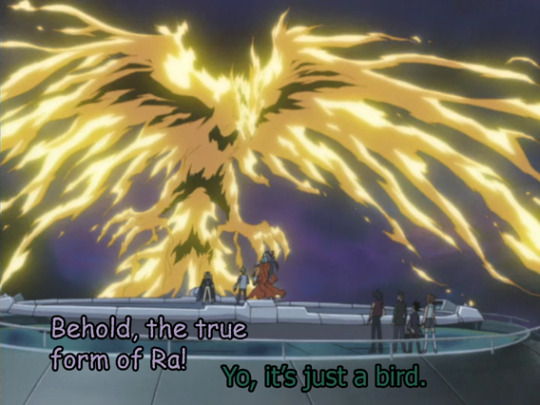
Man, were there a lot of phoenix references in the 00′s or is that just me who read way too much Harry Potter?
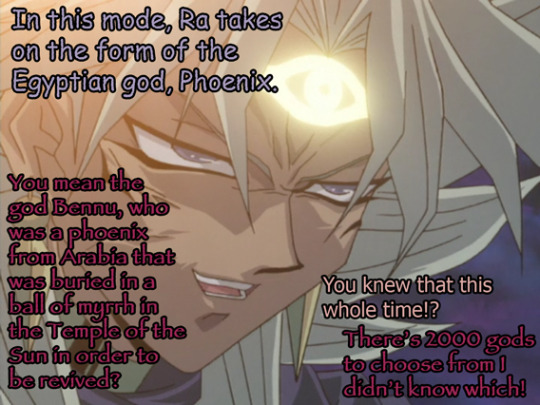
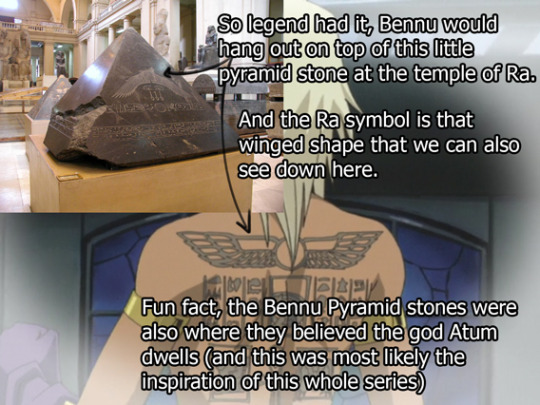
And like, because I do draw Yugi sometimes, occasionally people will reblog and tag with Pharaoh’s real name in there (I can’t really avoid that spoiler), so I think it’s pretty likely his name comes from Atum of Egyptian legend. Who...wasn’t really a Pharaoh. Atum was kinda weird, he gave birth to...himself. He’s an interesting read. But, we’ll get there when we get there.
But, I didn’t really know about Bennu pyramids until I actually went and looked up Egyptian Phoenixes. I had always thought that the Phoenix was Greek in origin but, according to Wikipedia some people say it happened in Egypt as well. And if it’s good enough for Wikipedia, it’s good enough for Yugioh.

The return of the mystery purple moisturizer jug and it brought it’s entire extended family of fiji waters.
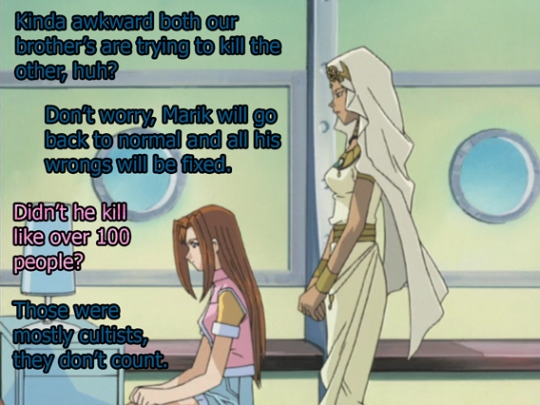
And so, Ishizu decides to do the right thing and take care of Mai. Not sure what Ishizu knows about being a nurse since she lived underground, but since she can help cure poisonous snake bites, maybe comas are a little bit easier?
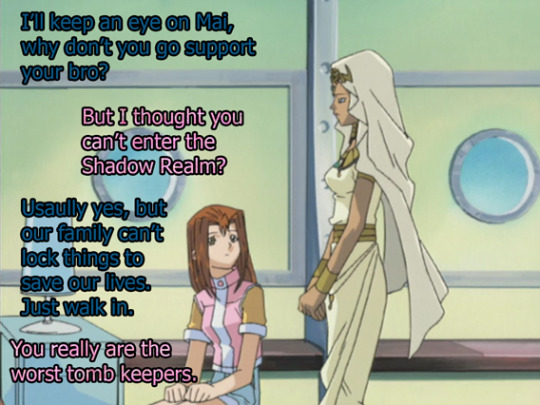
And so Serenity starts the 30 minute jog up the phallic tower to get to Joey’s death sequence. She’s made it to about...20 ft outside of the plane by the end of this episode. Serenity runs kinda slow.
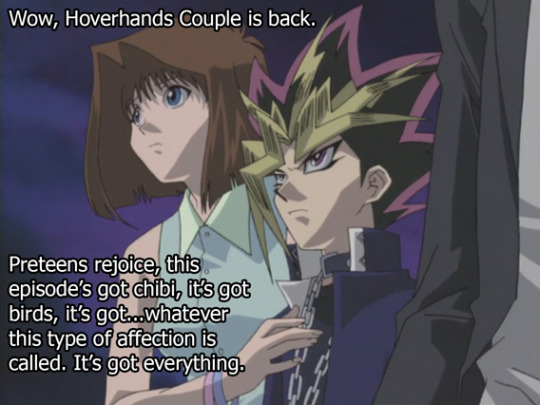
Bro mentioned that he thinks it looks like Tea’s trying to very stealthily steal Yugi’s wallet. And that’s just my spicy headcanon now, too.
Well now that’s over, lemme see if...

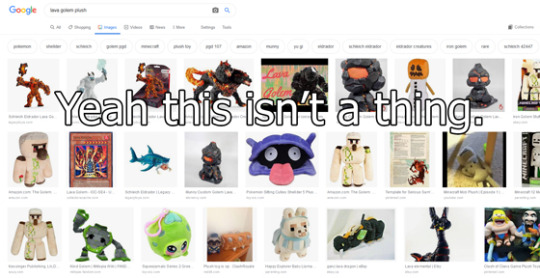
.......it could’ve happened. It only has like a couple of human skulls on it.
And hey if this is the first recap you’ve ever seen from me, here’s a link to read them all from the beginning in Chrono order, back when they weren’t color coded and I had no idea what the hell I was doing.
#Yugioh#yu gi oh#yugioh recap#photo recap#episode recap#s3 ep29#s3 ep30#Lava Golem#yugi muto#I wasn't expecting actual egyptian mythology to be in this show#joey wheeler#marik ishtar#serenity wheeler#ishizu ishtar#seto kaiba#tea gardner#tristan taylor#duke devlin
21 notes
·
View notes
Text
Bird Logo Design: Examples and Bird Symbolism
An animal logo (or a bird logo in this case) has many design conveniences.
Animals are easy to identify with, and will help your brand be instantly recognized by billions of users.
And while it is true that bird symbolism is overwhelming nowadays, it still caters to the main mission – creating a business identity each customer can easily remember.
A bird logo is always a good idea, thanks to the beauty and gentleness of these creatures. Designers find it easy to choose between the versatile colours and shapes. In a nutshell, there is much creative people can do with a simple graphic bird symbol in hands (think of the Twitter bird logo, for instance).
Companies with bird logos – what message are they trying to share?
Birds are not only symbols of freedom and flying, but also a visual representation of communicativeness. Even the simplest logos with birds (including those drawn with a single line) are instantly related to the service they promote.
If it is a cartoon bird, it clearly stands for a children brand (penguins and ducks in particular), while an illustration of a glorious peacock is almost always the bird logo of expensive and luxurious brands. As a part of your bird symbolism strategy, you should first decide which message you want to convey, and then let the cute animal ‘speak’ it up.
Choose colours that tell your story
What is really cool about logos with birds is that they offer almost unlimited design possibilities, letting us choose between all sizes, shapes, and colours. To make a bird logo more personal, you can always use a pop of unexpected colours, or make a cartoon/caricature of the animal in question.
Green doves or purple ducks, for instance, would look very intriguing, especially if you add a hat or a monocle to make your logo unforgettable.
Bird logos are not a recent trend. These cute animals impressed people since the beginning of time, often attached a specific meaning and conveying an important message. Asian people, for instance, associate birds to immortality, in particular East Indians who have a myth relating birds with the souls of the department.
In the Christian culture and art, on the other hand, birds are considered the embodiment of the Holy Spirit, and often symbolize peace and safety.
At the same time, birds are used to share human moods, urges, and emotions, most of the time the positive ones. With a gentle dove you can represent divine and devotion, with a flirtatious Partridge or a proud Cockerel an amorous and polite gentlemen, and with a Rooster the heritage and tradition of a country.
An image of a vulture may remind the observer of a strong and masculine boy, while a conjugal bliss would often remind them of a lifetime friend. To express affection, you can also consider a tiny Mexican parrot or a hummingbird logo, which are both considered love birds, and pinpoint closeness and affection.
Yet, the meaning of a bird symbol will likely depend on your location – if you’re in rural Africa, for instance, a hen would remind you of maternity, and the very same symbol in Great Britain would stand for beauty and love.
Nautical Tattooing uses parrots as main symbols, while sailors prefer bluebirds and swallows.
The feathers, beaks, and wings of birds remind designers of the development of the human body and soul, depicting visually a person’s entire journey, from birth to departure to the ancestral lands.
A bird was also chosen to be the symbol of creation of Egyptian’s God Atum, and a victory association for the Goths and the Vikings.
The Odin and Norse Gods’ favorite bird was the raven, commonly related to wisdom and transformation. North America’s shamans consider them to be tricksters and shape-sifters.
Had you asked the people from Hilda (Pacific Northwest) what ravens meant to them, you’d discover that these birds are a symbol of creation and the creatures that stole the sun to let it shine.
The Rooster was even mentioned in the Bible, praised for the ability to call his flock to eat. The Bluebird (or Swallow) is the traditional symbol of Chinese sailors who believe it is their mysterious good omen, and a sign of hope.
The meaning of birds throughout history
– Cranes symbolize health, longevity, wisdom, good luck, and happiness
– Eagles stand for power, courage, and resurrection; they are always related to sun and heaven, and often used to symbolize rebirth
– Owls represent wisdom, virtue, experience, but also darkness and death
– The dove has always been related to peace, purity, and gentleness. It is also a recognized symbol of the Holy Spirit.
– Peacocks herald new growth, birth, longevity, spring, and love. You will also find them visualizing royalty, compassion, prosperity, peace, and luxury. In China, they are considered to be sacred, while in India people recognize them as national birds
– Ducks look protective, and create emotional comfort for the viewer.
– Swans are very loyal birds that symbolize friendship and family. People perceive them as protective, yet tender creatures with a healing and prosperous energy.
Translated to commercial values, the meanings of bids give us plenty to think of before we launch a logo design. The traditional beliefs and perceptions may get lost along the way, and the result may turn out even better.
What matters is to depict the exact connection between a bird’s meaning, and the identity of a business. Different companies will, of course, approach the matter in a different context, but you will still be able to identify their personal message in a seemingly common bird image.
Regardless of how you’ve chosen to use them, bird logos will always be associated predominantly to positive things, including the joy, goodness, and intelligence of the human soul. Western art movements work with birds to symbolize a person’s journey towards the future, and associate them with beauty, hope, and transcendence.
Ending thoughts on bird logo design
Companies with bird logos are everywhere around us, and for a good reason. From old and wise owls to peaceful doves, bird symbols can have an incredible number of meanings, and are thus suitable to promote any type of brand, cause, or idea.
In the sports world, for example, you will often see majestic eagles and competitive falcons, both used as symbols of power and strength. In most cases, birds are used to symbolize flying and freedom, excluding, of course, the penguins and the ducks.
If you liked this article with bird logos, you should check out these as well:
Heart Logo Design: Inspiration and Brands That Use It
Typography Logos That You’ll Enjoy Looking At
Cool Logos: Design, Ideas, Inspiration, and Examples
Logos on Pinterest
Logos from UCreative
The post Bird Logo Design: Examples and Bird Symbolism appeared first on Design your way.
from Web Development & Designing http://www.designyourway.net/blog/graphic-design/bird-logo-design-symbolism/
0 notes
Link
http://ift.tt/2w0DrmM
The Egyptian Sphinx, aka the Great Sphinx of Giza, leaves a huge mystery to anyone who sees it. Although it has been established that the gigantic statue was created by man, it is still not clearly identified why it was built. Some say ancient people built it due to mythological beliefs and to pay homage to a supreme deity. Meanwhile, others say that the rulers of the past forced slaves to build it for their own satisfaction even if many people have died to construct it. Others just think the existence of the Egyptian Sphinx is alien in nature altogether. Still, many people of today believe that the Egyptian Sphinx is a historical treasure regardless of the reason why it was built. Although its existence is difficult to understand, many locals are happy that is just does. Overall, the Egyptian Sphinx is a mystery but there is more to that than just its existence. Here are some other quirky details about the giant statue that you probably didn’t know and will blow you away.
#1 The Egyptian Sphinx Is The Oldest Statue The Egyptian Sphinx is believed to be the oldest statue ever built in human history. Although its actual creation is still undetermined, its age seems to be way far in the past compared to other statues discovered. However, even if it is the oldest statue, it is not the oldest Sphinx. Apparently, even if the Egyptian Sphinx is dated during Khafre’s rule, there were already Sphinx found that demonstrate his half-brother and sister that are much older than the Egyptian Sphinx.
#2 The Egyptian Sphinx Is The Biggest Rock Statue Although the Egyptian Sphinx is not the oldest representation of the Sphinx, it is the oldest statue nonetheless, it is also the biggest monolith statue on the face of the earth. The Egyptian Sphinx stands tall at 66 feet and has a length of 241 feet. With this, it is amazing how ancient people were able to carve out this massive monument. Hence, what is even more amazing is the motivation to build this. The Egyptian Sphinx is truly a mystery that is still yet to be solved.
#3 Over The Years, The Egyptian Sphinx Had Different Names The Egyptian Sphinx has been in existence for so many years and over those years, it came with different names. Apparently, it was not always called the Egyptian Sphinx. For instance, in 1400 BC, the massive monument was called “statue of the very great Khepri.” The reason for this was that because Thutmose IV slept beside it and had visions of the god Horem-Akhet-Khepri-Re-Atum, which revealed that he was Thutmose’s father and in order to be a true ruler, he needed to clear the sand in the area of the monument. Later on, the Egyptian Sphinx was called “Horem-Akhet” or “Horus of the Horizon.” Other names for it included “balhib” and “bilhaw”.
#4 It Used To Be Buried In Sand The Egyptian Sphinx spent a great deal of time buried in the sand due to the shifting sands of the desert where it is located. Since it has been around for a long time, it has experienced some of the harshest desert weathers, which has buried it, especially its body, under the sand. The first restoration of the statue on record due to being buried in sand happened in the 15th century. It was an effort by Thutmose IV. After 3 millennia, the statue got buried in the sand again. In the start of the 19th century, even the arms of the Egyptian Sphinx were under the sand. The statue was excavated and restored again in the 1920s.
#5 There Was A Time When It Lost Its Crown Due to sand shifting and many restoration efforts in the 1920s, there was a point in time when the Egyptian Sphinx lost its crown. Moreover, the famous statue also experienced intrusive damage on its head and neck back then. Hence, in 1931, the Egyptian government poured an all-out effort to bring back the original look of the statue. However, these efforts produced more bad than good due to their use of soft limestone. An accident due to this restoration happened in 1988 when a 700-lb piece of the shoulder fell. Good thing, no one got hurt. To fix this, a massive restoration effort was done later on.
#6 The Sphinx And Its Missing Nose Contrary to what many believe that Napoleon Bonaparte was the reason behind the Egyptian Sphinx’s missing nose, it was debunked by many documents. The Sphinx’s nose has been missing for a quite some time and people have been blaming Napoleon for blasting it away. However, earlier sketches show that the Sphinx’s nose had already been missing before Napoleon was born. Moreover, there were historical documents found that say devout Sufi Muslim Muhammad Sa’im al-Dahr was the one who destroyed the Sphinx’s nose. This was to weaken the worship of the giant statue.
#7 The Egyptian Sphinx Used To Have Colors At present, it is hard to believe that the Egyptian Sphinx used to be colorful. The giant statue is now tan. It is almost color-less when seen with its sandy surroundings. However, it has been observed that the Egyptian Sphinx was wrapped in different colors back in the day. It can be noticed that it still has some red paint on its face. It also has splashes of blue and yellow on its body. Therefore, experts believe that the original look of the statue was in vibrant colors. However, with time and the conditions in the desert, the colors disappeared, leaving only a few traces as reminders.
#8 It Used To Have A Beard There has been physical evidence that the Egyptian Sphinx used to have a beard. There are remnants on its face that show it used to have one, but was removed due to erosion. Moreover, the other part of the beard that was removed is now housed at the British Museum and in the Museum of Egyptian Antiquities in Cairo. Still, some experts believe that the beard was not an original part of the monument but was just added later on. Even the British Museum supports this and states that the beard was possibly added on the statue after the restoration efforts done by Thutmose IV.
#9 The Egyptian Sphinx Is A Nicer Counterpart To The Greek Sphinx The Greek Sphinx, made famous in the story of Oedipus, is known for being full of tricks and deceit. In the Greek mythology, the Sphinx challenged people passing by with a riddle and those who were not able to solve it were killed. It was only when Oedipus came along and solved the riddle that they trickery of the Greek Sphinx ended. Meanwhile, the Egyptian Sphinx is much nicer. It is known to be benevolent as told by its cult following. Although it is also powerful, it is a kinder version of the Greek Sphinx.
#10 No Specifics On Who Really Constructed The Monument As we’ve said, although historians and experts have established that the Egyptian Sphinx was built by humans, no one really knows exactly who had it built. The experts’ community is split in providing the specific time it was built, which will help determine the Pharaoh who asked for it to be built. However, a popular belief is that the monument was built during the regime of Khafre of the Fourth Dynasty of the Old Kingdom way back in 2500 BC. Another proof to this theory is the similarity of Khafre’s face to the Sphinx’s face, which leads many to believe that he asked it to be built in his likeness.
#11 Whoever Built It, Did Not Finish It Apparently, according to historical study, the Egyptian Sphinx was intended to be more glamorous than what it is today. From the discovery of American archaeologist Mark Lehner via aeraweb.org and Egyptian archaeologist Zahi Hawass, they found large stones and construction tools in the area. Hence, they drew the conclusion that the Egyptian Sphinx was not finished for some unknown reason. Looks like whoever was building it, abandoned the project mid-way. Still, it is an amazing historical piece that leaves many who see it dumbfounded.
#12 Those Who Built It Had A Luxurious Diet Contrary to what many people believe that the people who built the Egyptian Sphinx were slaves and were treated as such, American archaeologist Mark Lehner discovered otherwise. Many scientists assume that the builders of the Egyptian Sphinx toiled to death and were treated badly, hence, were not fed properly. However, according to the discovery of Lehner, the builders were provided with luxurious meals. He discovered from the excavations in the surroundings of the Egyptian Sphinx that the builders had regular meals of prime cuts of beef and sheep.
#13 The Egyptian Sphinx Has A Cult Following A long time after the Egyptian Sphinx was constructed, it earned its own cult following. The main reason for this is due to Thutmose’s visions while sleeping near the giant monument. Moreover, the Egyptian Sphinx was thought by many people to be a representation of a supreme being, which made it even more popular. Back in the day, rulers even commanded the creation of temples where people could venerate the Egyptian Sphinx. Until today, the enormous statue still has a community of loyal followers.
#14 The Statue Is A Focus Of Many Theories The mystery that wraps the Egyptian Sphinx is the reason why it is front and center many theories. Even astronomical theories put it in focus, which provides claims on how the ancient Egyptians have a deep understanding of extraterrestrial concepts. American archaeologist Mark Lehner, even mentioned in his studies that the Egyptian Sphinx and the Pyramids of Giza were built to harness power from the sun. In another theory, British writer Graham Hancock said that there is something mysterious with the alignment of the Egyptian Sphinx, Pyramids of Giza, Nile River, Leo and Orion constellations, and the Milky Way. However, no further explanation can be found. Also, the mystery remains a mystery.
#15 Not Really A Sphinx If we are speaking in technical terms, the Egyptian Sphinx is not really a Sphinx. By definition from Wikipedia, a Sphinx is “a winged monster of Thebes, having a woman’s head and a lion’s body. It propounded a riddle about the three ages of man, killing those who failed to solve until Oedipus was successful, whereupon the Sphinx committed suicide.” The Egyptian Sphinx seems to not have wings, which somewhat blurs its resemblance with the definition. Moreover, the Egyptian Sphinx has features of a male, which is opposite to the Sphinx in the story of Oedipus, which is a woman.
0 notes
Text
Akhenaten
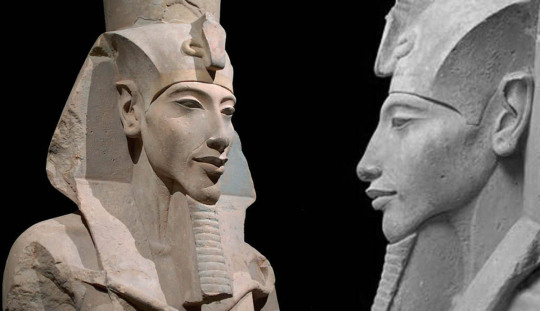
The name Akhenaten is rather well known as a Pharaoh of Egypt. Like Ramesses II, Hatshepsut, Cleopatra, and Tutankhamun, Akhenaten won the popularity contest of modern society through defining himself as far different from most other Pharaohs. With Akhenaten, however, he’s not even like the special Pharaohs.
Let’s look a little at his life and the history of the time period he ruled over. He was in the 18th Dynasty of the New Kingdom, from 1353-1336 BC. Like most Pharaohs there are a few different pronunciations of his name, including Akhenaton, Ikhnaton, Khuenaten, all meaning of great use to Aten, which leads into his conversion into the cult of Aten. Before the conversion his name was Amenhotep IV, son of Amenhotep III. His mother was named Tiye. Later on in life he married Queen Nefertiti, fathering two children, one from his wife Nefertiti and one from his lesser wife, Lady Kiya, having Ahnksenamun and Tutankhamun to each wife respectively.
Before we get into the whole mess of his religion and the ‘revamping’ he did of ancient Egypt, let’s recognize the other things he did for or to the country.
You’ll recognize the vastly different art style between Akhenaten’s rule and the history of most of Egypt. In art that depicts Akhenaten, he was shown as long and spindly, a style that carried into his family. Some people believe that this was because he and his family suffered from Marfan’s syndrome, a disease that caused the elongation of bones and skinniness. A more likely explanation stems from the Pharaoh’s religious beliefs, which as you know, was vastly different from other Pharaohs. This theory is a little more likely because there was no reason for the queen Nefertiti to have the same condition as her husband. Instead, it was probably because their status was far different from the other Pharaohs, as they were moved into a genuinely god-like status for their worship of Aten.
The part of Akhenaten and his rule that interests me the most is the way the royal family was presented in art, despite the style. Like many parts of Akhenaten, it’s entirely different from other Pharaohs (though, whether that’s good or bad is up to you).
Now, most Pharaohs presented themselves highly in art. They could do that, so why not? If I had the guts and the money I probably would too, but my point is that essentially all Pharaohs depicted themselves alone on stelas, engaging in hunting or other activities that strengthened the image of themselves that they wanted to show the world. Usually they were masculine tasks that could be done only by those with great strength and great riches. Akhenaten went in an entirely different direction; he depicted himself with his family. In the stele of Akhenaten, he is shown in a private way, the scene being him with his family, enjoying themselves together.
While we can’t say the definitive reason for him presenting himself as this, the most logical conclusion has to do with, again, his religious beliefs. In his mind, the Aten was held above all else, even the Pharaoh. With Aten as the highest consideration, the Pharaoh and his family enjoyed their lives under the influence of the Aten’s love and grace.
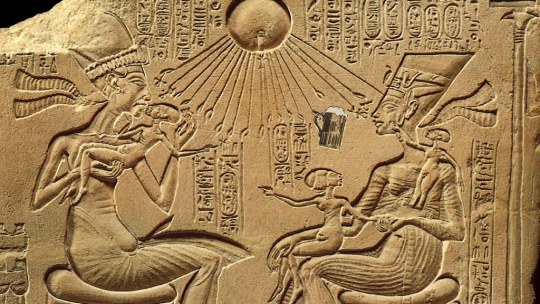
Now that we have a little insight, let’s get into the whole mess of his religion that died immediately after he did.
Akhenaten originally reigned as Amenhotep IV, a reign that lasted around five years before he switched religions. Changing his name, he converted to a cult that worshipped Amun to that of Aten, abolishing the ancient rites of those before him, and instituting what is believed as the first example of monotheism state religion in the world. His rule as Akhenaten lasted 12 years, during which he was labelled as the infamous ‘heretic king’, so that should give you some insight into how people felt about him.
Before his rule, the cult of aten was a cult like all others in Egypt. It was a bit like choosing your favorite God – find the one you like most, and join that cult. For example if I were to join a cult, I would join the cult of my favorite God, Ma’at. I mention this because before the change, the Aten was shown in inscriptions of Akhenaten (Amenhotep IV at that point), represented by the sun disk. It’s also important to note cult doesn’t carry the same meaning as it did then, and each cult shared the same goal: balance and eternal harmony.
At the time of Amenhotep IV’s rule the Amun cult (where the Aten is from) held incredible power. Their power had been growing for a long while, and by the time of his rule, they held nearly as much power and riches as the Pharaoh himself, and actually owned more land than Amenhotep IV. The fifth year of his reign he switched everything; this was when he abolished the practices of the previous religion of Egypt, and proclaimed himself the “living incarnation of a single all-powerful deity known as Aten,” (Joshua J Mark), and by the ninth year, he closed every single temple, prohibiting all the old practices and devotion to the many Gods the people of Egypt worshipped.
Around then was when he moved the royal seat of Egypt from the traditional house of Thebes to a city of his own creation, a city named Akhetaten, and with that he changed his name to Akhenaten. Here he earned the name the Heretic King, earning the ire of some historians and the admiration of others.
Despite the fact that Akhenaten’s influence completely destroyed worship of the Gods many Egyptians loved, one of the main problems with his rule was that the Old Gods of Egypt instilled harmony and order in the citizens, ultimately helping to create a country that lasted over 4,000 years. Without these Gods, things got a little wonky.
Religious tolerance was allowed with the many Gods, emphasizing peace to the point where religious intolerance wasn’t even an issue. Unfortunately, for monotheism to work, there has to be something inherently wrong with the other side, which made Akhenaten’s work a lot harder, and its’ effects much stronger. It led to the intolerance of other beliefs and some severe suppression, and if you look at the monotheistic religions of today, you can see the same sort of pattern. With intolerance comes hatred and war.
“Dating to this point in Akhenaten’s reign was a campaign to excise the name of gods other than the Aten, especially Amun, from the monuments of Egypt. This was done with violence: hieroglyphs were brutally hacked from the walls of temples and tombs. This was probably carried out, at least in part, by illiterate iconoclasts, presumably following the orders of their king. [Akhenaten] carried out a religious revolution the like of which had never been seen before in Egypt.” (Zahi Hawass, 42-43).
There were priests of Atum who attempted to hide religious artifacts, storing statuary and texts away from the soldiers ordered to destroy them. The priests, with nothing left to do, were forced to abandon their temples. In response Akhenaten either hired new priests or forced the other ones to obey him, proclaiming him and his wife once more as Gods on earth.
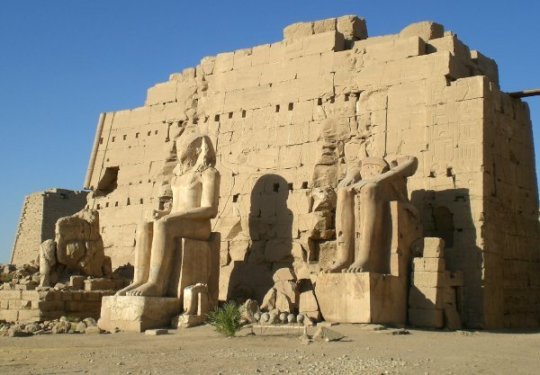
Now you can see how Akhenaten kind of sucks. Let’s talk about how he sucks even more.
His foreign policy.
With his ego inflated to the size of the sun, Akhenaten thought himself above interactions with foreign powers. He left his duties to spend more time on himself and his family, ultimately leading to a severe neglect.
You might be asking, “didn’t every Pharaoh have a super-inflated ego?” and yes, you’d be right, but no Pharaoh before Akhenaten had genuinely claimed themselves to be a God. As a self-proclaimed incarnated God, he must’ve thought such affairs beneath him.
Discovered through letters of the time, several (former) allies of Egypt had asked for their help several times with various affairs. At the time Egypt was wealthy, prosperous, and strong, a state that had been slowly growing before halting at Queen Hatshepsut’s reign. Hatshepsut and her successors employed a strategy of actually doing work, by working out when to approach with diplomacy, and when military action was required. Akhenaten on the other hand, ignored everything outside of his palace at Akhetaten.
The uncertainty of Akhenaten’s rule, along with letters of correspondence between the city of Amarna, the Pharaoh, and foreign nations, led to this era being called the Amarna period. These very letters were proof of the Pharaoh’s negligence. However, the letters also show his keen eye in foreign diplomacy, if the situation interested him so. It was a whole thing with the Hittites, but since this is chiefly about Akhenaten, I���ll leave that topic for later. All you really need to know is that he only tended to issues that affected him directly, and through the Amarna letters, historians can see how poor of a King he was, as well as how deeply many of his subjects disliked or despised him.
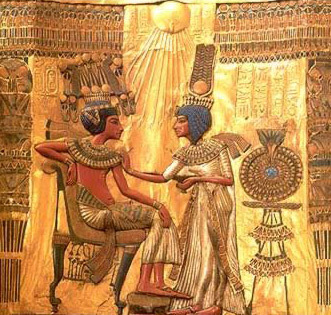
Essentially, the main reason this mess didn’t work out was because it brought about something new: exclusivity. And the Egyptians did not like that, believing that the world needed to have a balance in order to stay away from slipping into chaos. In the end monotheism didn’t last; hell, it was ended basically the second Akhenaten’s son took the throne. Tutankhamun, originally named Tutankhaten, changed his name to reflect the return to polytheism. His successors tore down the reminders of Akhenaten’s reign, removing him and his adoration for the Aten, eradicating his name from the record.
There’s no saying he didn’t affect the world – he did, a lot. Whether that affect was good or bad is up to the interpreter (personally I don’t like it all that much). By Freud’s thinking (hear me out, I know he sucks) Akhenaten’s rule inspired the ancient world, leading others to copy his ideas and theology, eventually snowballing into our modern world, where there are essentially no polytheistic religions. You have to give him credit – he was the first person of the ancient world to dream up monotheism, changing what had defined humanity for so long.
With his name stricken from the books, historians only discovered him upon finding his city Akhetaten. In the records, Horemheb is labelled as Amenhotep III’s successor, skipping over both Akhenaten and Tutankhamun’s rule. Later when Tutankhamun’s tomb was found as one of the very few graves still filled with treasure, interest spiked in Tutankhamun’s life, eventually leading back to his father Akhenaten.
88 notes
·
View notes